Don't wanna be here? Send us removal request.
Text
Global U.S. Speech Therapy Market Is Anticipated To Witness Growth Due To Increasing Prevalence Of Neurological Disorders And Growing Research Activities

Overview:
Speech therapy can improve the quality of life for a person with a speech disorder. It can also help people who have swallowing difficulties or have problems with reading. Speech therapy can be done in a classroom setting or at home. It can take a long time for therapy to work. However, with patience and practice can help the child in improving. During speech therapy, a speech-language pathologist works with a child to help improve communication skills. They can help people with a variety of different speech and language disorders. These disorders can be caused by a number of different factors. They can affect a child's ability to speak, listen, read, write, swallow and chew. One type of speech disorder is dysarthria. This disorder causes weakness in the muscles of speech. It may be caused by a neurological disease, a head injury, or facial paralysis. It may also be caused by an infection.
Market Dynamics:
Rising incidences of speech disorders and increasing investments are anticipated to propel growth of the global U.S. speech therapy market over the forecast period. For instance, Expressable has raised $4.5 million in May 2021, for serving almost five million children with communication disorder in the United States of America. Moreover, increasing cost for speech therapy is estimated to restrain growth of the global U.S. speech therapy market over the forecast period.
Impact of COVID-19:
The pandemic resulted in impacting the financial status of many businesses in many sectors of the society around the world. Many supply chains were disrupted owing to the travel bans imposed in many regions. The pandemic forced many industries to shut down their operations owing to the strict nationwide lockdowns imposed by the government in many regions. There was a dip in the number of speech language pathologists owing to the pandemic. Key players active in the speech therapy market were conducting online speech therapy sessions so as to ensure the growth of the market. Many patients in need of the speech therapy treatments were taking these sessions online and this had a positive impact on the market. So the pandemic had a mixed reaction on the growth of the global U.S. speech therapy market.
Key Takeaways:
The global U.S. speech therapy market is estimated to witness significant growth, exhibiting CAGR of 5.4% during the forecast period, due to growing product launches. For instance, world's first online speech therapy club has been launched by two pediatric speech and language therapists in March 2022, for addressing the crisis affecting preschoolers’ globally.
North America is estimated to witness significant growth in the global U.S. speech therapy market over the forecast period, due to growing prevalence of Alzheimer's disease and rising screening tests for newborn babies in the region.
Key players active in the global U.S. speech therapy market are The Hello Foundation, Genesis Rehab Services, Teamwork Therapies, Speech Therapy Solutions, Inc., LA Speech Therapy Solutions, Reliant Rehabilitation, Easy Speech Therapy Center, Kindred Healthcare, LLC, Rehabilitation Associates, Inc., Smart Speech Therapy LLC, and BenchMark Physical Therapy Institute.
0 notes
Text
Antifreeze Proteins Market Future Business Opportunities 2023-2028
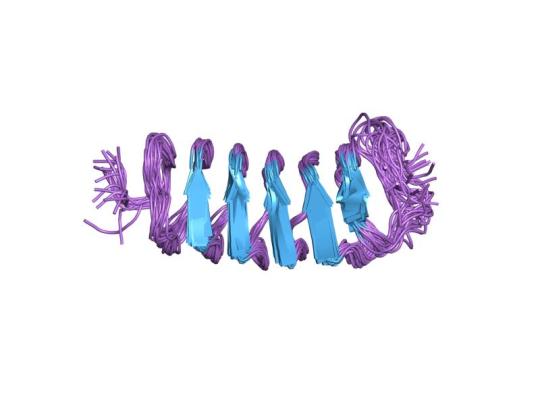
Global Antifreeze Protein Market - Impact of the Coronavirus (COVID-19) Pandemic
Coronavirus (COVID-19) outbreak was first reported on December 31, 2019, in Wuhan, China. The World Health Organization declared COVID-19, as pandemic on March 11, 2020.
For instance, according to the Coronavirus (COVID-19) Weekly Epidemiological Update by the World Health Organization, over 172 million cases and 3.7 million deaths due to coronavirus (COVID-19) were reported till June 06, 2021, across the globe.
Impact of COVID-19 on Demand and Supply of Antifreeze Proteins
The COVID-19 pandemic and lockdown in various countries across the globe have negatively impacted the financial status of businesses across all sectors. The COVID-19 pandemic has negatively impacted the entire supply chain of the pharmaceutical industry, food & beverage industry, cosmetics industry, and others mainly due to strict lockdown in several regions. However, the demand for antifreeze proteins is increasing in this COVID-19 pandemic due to a growing need of development of new vaccine candidates for treatment of coronavirus cases. For instance, according to the Business Standard Report 2020, there is an increased pressure on the governments all around the world to ensure proper storage and transport facilities for distribution of newly approved COVID-19 vaccines. For instance, according to the Centers for Disease Control and Prevention (CDC), Pfizer vaccine need to be stored at a very low temperature of about -70 degree Celsius. Antifreeze proteins are used to maintain the structural stability of vaccines stored under subzero temperature conditions.
Thus, impact of the coronavirus (COVID-19) pandemic is expected to boost growth of the global antifreeze proteins market during the forecast period, owing to the increased demand of antifreeze proteins for storage of COVID-19 vaccines.
The increasing product launches and approvals are the major factors that are expected to drive the market growth over the forecast period
The increasing launches of products and approvals are expected to drive growth of the global antifreeze proteins market over the forecast period. For instance, in May 2021, AquaBounty Technologies, a U.S. biotechnology company launched genetically engineered salmon, which is the first of its kind in the world and also the only one to be currently available for commercial harvest. This newly developed genetic modification technology will enable the company to produce 70% more salmon than the traditional methods of spawning and breeding. A boost in product launches in the field of frozen fish is expected to boost the antifreeze protein market as these proteins are widely used as a preservative for storage of frozen fish.
0 notes
Text
Bioinformatics Platforms Market is expanding with Dassault Systemes SE acquiring Medidata Solutions to take leverage of Medidata’s cloud-based services to help the development of therapeutic innovations
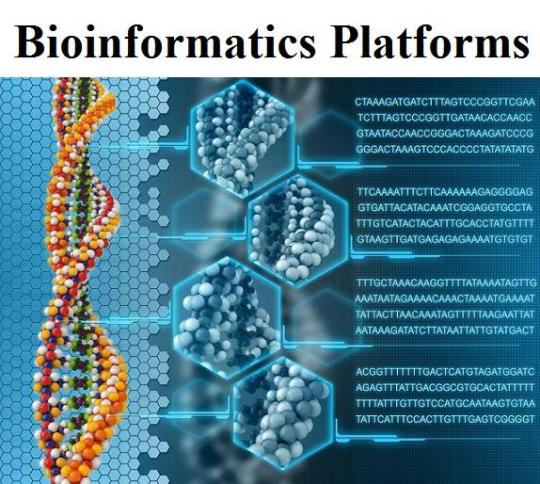
Developed regions such as North America, typically the U.S. have shown the most promising signs when it comes to the bioinformatics platforms market. This is due to high adoption of new and advanced technology, which is complemented by continuous research and development activates in the region. Similarly, Asia Pacific is witnessing increased interest in the field of bioinformatics platforms due to the presence of skilled personnel.
Bioinformatics Platforms are collections of software applications designed to facilitate the analysis of biological information. The applications and their main functions are divided into three categories, these are Cloning Lines of Action, Gene Regulation, and Gene Function. They all can be combined into one application for better functionality. However, the applications vary depending on the needs of the user and the complexity of the job. Bioinformatics is widely used in research and development activities for either drug discovery, clinical diagnostics, or personalized medicine. Such thorough and highly advanced research activities require collaborative work, in order to leverage the expertise of both private and public organizations. Recently, in October 2020, The Walther Cancer Foundation invested around US$ 11 million to expand collaborative bioinformatics cancer research with Indiana University and Purdue University. Similarly, in January 2021, Curie-Cancer entered into a bioinformatics partnership deal with GenoSplice Technology for the application of cancer genomics. Such partnership and collaboration activities can stimulate growth of the bioinformatics platforms market.
Bioinformatics platforms are usually developed using applications written in C++. The source code is made human-readable to allow users to quickly analyze the data and manipulate it. Examples of these applications include the Illumina Genomics Platform, Gene Array Expression Profiling Software, and Genomics Data Migration Tool. In the recent past, the demand for nucleic acid and protein sequencing has increased massively. This is due to the fact that sequencing cost has reduced substantially, which is complemented by technological advancements. Such positive factors are also augmenting growth of the bioinformatics platforms market.
Recently, in June 2019, Dassault Systemes SE, a French software company, acquired Medidata Solutions, a provider for SaaS-based clinical development software, for US$ 5.8 billion with the aim to take leverage of Medidata’s cloud-based services to help the development of therapeutic innovations and clinical operations performance for pharmaceutical companies.
Good bioinformatics applications should be open source. This means the software should have a collaborative development plan and be collaboratively supported. Currently, there are many open-source applications available. To see what applications are currently out there check out the Bioinet website. Despite all these positive factors, the bioinformatics platforms market is hindered by a lack of well-defined standards and common data formats for the integration of data. Besides, the low availability of user-friendly tools at competitive prices can restrain growth of the bioinformatics platforms market.
0 notes
Text
High Prevalence of Osteonecrosis to Augment Growth of Osteonecrosis Treatment Market
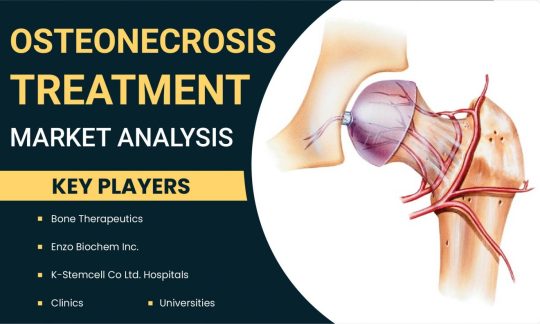
Osteonecrosis is a medical term meaning "bone death." It is caused by an inflammation of the hip joint due to a reduction in blood supply. This type of bone disease can have an extensive impact on the quality of life of individuals suffering from it, making the treatment of osteonecrosis extremely important.
Market Dynamics
High prevalence of osteonecrosis is expected to propel growth of the osteonecrosis treatment market. For instance, according to the study, ‘Epidemiology of osteonecrosis among older adults in Sweden’, published in Springer in January 2019, the 10-year risk of osteonecrosis was 0.4% and the incidence rate was 4.7 cases/10000 person-years. Moreover, high prevalence of osteoporosis is also expected to aid in growth of the osteonecrosis treatment market. For instance, according to a study published online in February 2020 in the Journal of Clinical Endocrinology & Metabolism, for denosumab-treated women with postmenopausal osteoporosis, invasive oral procedures and events (OPEs), including dental implants, tooth extraction, natural tooth loss, scaling/root planning, and jaw surgery, are common and associated with osteonecrosis of the jaw.
High prevalence of cancer is expected to offer lucrative growth opportunities for players in the osteonecrosis treatment market. For instance, in December 2020, a study by researchers from the SWOG Cancer Research Network, a cancer clinical trials group funded by the National Cancer Institute (NCI), part of the National Institutes of Health (NIH), and published in JAMA Oncology, found that 2.8 percent of patients on average develop osteonecrosis of the jaw, within three years of starting a common treatment for cancer that has spread to the bone. Moreover, increasing geriatric population is also expected to aid in growth of the market. For instance, according to the U.S. Census Bureau, the U.S. geriatric population is expected to reach 77 million by 2034.
Among regions, North America is expected to witness significant growth in the osteonecrosis treatment market, owing to high prevalence of cancer. For instance, according to the American Cancer Society, in 2019, there will be an estimated 1,762,450 new cancer cases diagnosed and 606,880 cancer deaths in the U.S.
Competitive Analysis
Major players operating in the osteonecrosis treatment market include, Bone Health, Bone Therapeutics, Enzo Biochem Inc., and K-Stemcell Co Ltd.
Major players operating in the osteonecrosis treatment market are focused on approval and launch of new products to expand their product portfolio. For instance, in December 2020, Bone Health’s OsteoBoost received the U.S FDA’s Breakthrough Device Designation to reduce the risk of osteoporosis.
0 notes
Text
Rising prevalence of colorectal cancer and other endoscopy-related diseases to boost the growth of endoscope reprocessing device market.

Market Overview:
Endoscope reprocessing devices are those which are made to kill the organisms in the reusable endoscopes using high disinfectants or liquid chemical solutions to expose the exterior surfaces and the interior channels. Manual cleaning, sterilization, documentation, leak testing and pre –cleaning are some of the steps performed in endoscopy reprocessing.
Competitive Landscape:
The major players operating the endoscope reprocessing device market are STERIS Plc., Cilag GmbH International, Steelco S.p.A., Minntech Corp PENTAX Medical, Medivators Inc., Wassenburg Medical B.V., Soluscope, ENDO-TECHNIK W.Griesat GmbH, Johnson & Johnson and Getinge AB.
Key Market Drivers:
Rising prevalence of colorectal cancer and other endoscopy-related diseases are anticipated to augment the growth of the global endoscope reprocessing device market. For instance, as per the American Cancer Society, nearly 97,220 people are diagnosed with colorectal cancer and 43,030 rectal cancer by the end of 2018.
Furthermore, increasing cardiovascular diseases which are treated with using ERs is anticipated to boost the growth of the global endoscope reprocessing device market. For instance, as per OECD, 45,307 people have undergone the coronary heart bypass surgery/operation in Germany as of 2018.
Covid-19 Impact Analysis:
During the pandemic, along with the sterilization the ERs have also increased as the reprocessors have been a crucial part for the endoscopy surgeries which led to the growth of the global endoscope reprocessing device market.
Key Takeaways:
The global endoscope reprocessing device market is expected to exhibit a CAGR of XX % during the forecast period due to frequent approvals, quick launches of products. For instance, in April 2019, Advanced Sterilization Products gained US. FDA, launched for the ASP AEROFLEX automated endoscopes reprocessors.
Among Regions North America, Asia Pacific and Europe are anticipated to witness robust growth in the global endoscope reprocessing device market due to increasing prevalence of diseases, frequent approvals. As per the Globocan, 3,244 people suffer from stomach cancer in Canada and 5,139 people suffer from pancreatic cancer.
0 notes
Text
Growing prevalence of cancer to augment generic oncology sterile injectable market growth
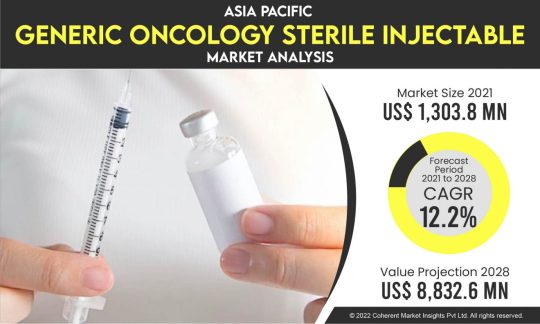
Market Overview:
Generic oncology sterile injectable are widely used for the treatment of cancers prostate, breast, colorectal, melanoma, lung, and bronchus. They have the same active ingredients as that of the branded version, with only the inactive contents of the drugs being different.
Competitive Landscape:
Eli Lilly & Company, Biocon Ltd., Baxter International Inc., Hikma Pharmaceuticals PLC, Mylan N.V., Sandoz International GmbH, Teva Pharmaceutical Industries Ltd., and Pfizer Inc.
Key Market Drivers:
Growing prevalence of chronic disease such as breast, prostate, colorectal, melanoma, lung, and bronchus is driving growth of the generic oncology sterile injectable market. According to the World Health Organization, cancer is a leading cause of death worldwide, accounting for nearly 10 million deaths in 2020, or nearly one in six deaths.
Increasing partnership and collaboration in the field of generic oncology sterile injectable is again fostering market growth. For instance, in February 2017 – Baxter International Inc. and ScinoPharm Taiwan, Ltd. announced a strategic partnership to develop, manufacture and commercialize five injectable drugs used in a range of cancer treatments, including lung cancer, multiple myeloma and breast cancer, as well as medication to treat nausea and vomiting, common side effects of chemotherapy.
Covid-19 Impact Analysis
Spread of Covid-19 has impacted the supply and demand of generic oncology sterile injectable. This is attributed to the imposed of lockdown and quarantine policies to curb the spread of infection.
Key Takeaways:
1. The generic oncology sterile injectable market is expected to exhibit a CAGR of 11.5% over the forecast owing to the growing prevalence of cancer.
2. North America is expected to gain significant growth over the forecast period owing to the growing initiatives by key players to expand production of generic oncology sterile. For instance, in July 2019, Nexus has entered into an agreement with Wisconsin’s village Pleasant Prairie for the development of a sterile injectable manufacturing facility.
0 notes
Text
Advancement in physical therapy is driving growth of Telerehabilitation services market

Market Overview:
Telerehabilitation is the application of information and communication technologies to provide rehabilitation services to patients or other healthcare professionals. It is also referred to as telecare, and it empowers individuals with a disability to take charge of their health and personal care. Using telerehabilitation services, patients can receive the same care as patients in a local health care facility.
Competitive Landscape:
270 Vision Ltd., CoRehab srl, SWORD Health, S.A., MIRA Rehab Limited, re.flex, Evolv Rehabilitation Technologies S.L., Brontes Processing Ltd., Bridgeway Senior Healthcare, Rehametrics, MindMaze , DIH Medical, and Doctor Kinetic
Key Market Drivers:
Increasing number of partnership and collaboration among key players is a major factor augmenting growth of the market. For instance, in October 2021, WizeCare Partners with Essen Health Care to advance value-based care through personalized all-in-one telerehabilitation platform.
Advancement in the technology is another major factor driving growth of the telerehabilitation services market. For instance, in November 2020, DKV has adopted the digital telerehabilitation platform ReHub as a technological solution to improve the assistance to users of its 1,400 affiliated rehabilitation centres throughout Spain.
Covid-19 Impact Analysis
The outbreak of Covid-19 pandemic has impacted the telerehabilitation systems market negatively due to travel restrictions. This has created shortage of raw materials and components that has affected the supply chain of the telerehabilitation service market.
Key Takeaways:
1. The telerehabilitation systems market is expected to exhibit a CAGR of 15.0% over the forecast period owing to the advancement in the telerehabilitation system.
2. North America is expected to witness significant growth over the forecast period owing to the continuous launch of new product in the region. For instance, in January 2019, MbientLab, a company building the next generation of sensors and tools for the healthcare industry, launched MIOTherapy (MIO), a wearable technology for physical and occupational therapists.
0 notes
Text
Europe Viscosupplementation Market Expected to Expand at a Steady 2023-2028
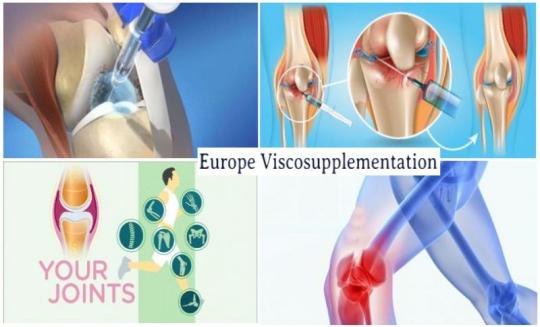
Viscosupplementation is a procedure in which hyaluronic acid (HA) is injected into the knee joint for the treatment of osteoarthritis (OA) of the knee. HA is a naturally occurring glycosaminoglycan and an integral component of synovial fluid and cartilage matrix present in the joints.
Europe viscosupplementation market is estimated to account for US$ 241.8 Mn in terms of value and is expected to reach US$ 343.6 Mn by the end of 2027.
Europe Viscosupplementation Market: Drivers
Increasing prevalence of OA is expected to propel growth of the Europe viscosupplementation market over the forecast period. For instance, according to the study, ‘Prevalence and development of hip and knee osteoarthritis according to American College of Rheumatology criteria in the CHECK cohort’, published in January 2019, in BMC Arthritis Research & Therapy, 63% of the participants in the Netherlands suffered from hip OA and 92% of participants with knee complaints were classified as having knee OA.
Moreover, increasing geriatric population is also expected to aid in growth of the market. For instance, according to Office of National Statistics, U.K. 2018, there are nearly 12 million people aged 65 and above in the U.K. of which 5.4 million people are aged over 75, 1.6 million are aged over 85, over 500,000 people are over 90, and 14,430 are centenarians.
Three injection cycle held dominant position in Europe viscosupplementation market in 2019, accounting for 59.5% share in terms of value, followed by five injection cycle, and single injection cycle, respectively
Europe Viscosupplementation Market: Opportunities
R&D related to viscosupplements is expected to offer lucrative growth opportunities for players in Europe viscosupplementation market. For instance, in May 2018, researchers from Humboldt-Universität zu Berlin and Berlin Institute of Health, Germany, reported that HA can influence the cartilage metabolism via upregulation of Metalloproteinase inhibitor 3 in OA-like condition.
In Europe, there has been a rise in the number of osteoarthritis patients seeking alternate options to knee replacement in view of avoiding the side effects associated with NSAID and corticosteroids injections. This factor has changed the overall scenario in the pharmaceuticals industry, propelling the inclination of the players in the market towards the viscosupplementation-based therapy.
0 notes
Text
PACS and RIS Market To Witness Substantial Growth Due To Growing Popularity of PACS around the World
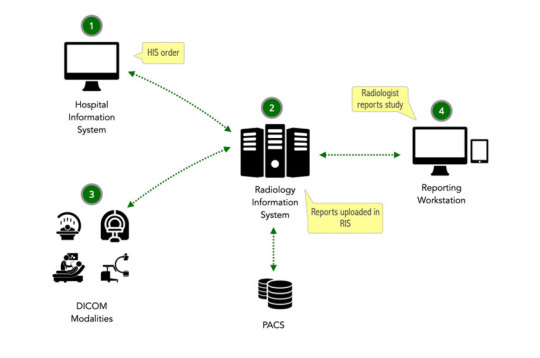
Overview:
A PACS system is a database of medical images and other medical information. It is generally stored in an RIS, though radiologists may choose to view the results directly in PACS. Cloud PACS solutions, however, allow radiologists to access even more information. Moreover, many providers boast of being able to integrate PACS with RIS. However, they are unable to quantify the integration time. RIS and PACS solutions are designed to facilitate interoperability among imaging devices. This is done by creating a standardized communication interface based on DICOM standards. The RIS acts as a master system that provides image management and move control functions.
Market Dynamics:
The popularity of PACS is growing all over the world and this is anticipated to propel growth of the global PACS and RIS market over the forecast period. PACS help to reduce the physical as well as time barriers linked to regular film-based retrieval, display and distribution of images. For instance, in August 2021, PaxeraHealth, developer of PACS/RIS announced to launch its novel product called PaxexaUltima 8th Generation, which is an AI-based imaging platform that provides AI algorithms for analyzing large data sets.
However, risk of cyber-attacks leading to growing concerns about safety of data in healthcare is likely to obstruct growth of the global PACS and RIS market over the forecast period.
Impact of COVID-19:
The coronavirus outbreak in China affected several industries around the world. Due to the virus outbreak many countries announced nationwide lockdowns. Several market activities including manufacturing, supply of raw materials and distribution activities were disrupted throughout this period. The demand for various products declined during the pandemic which adversely affected growth of several markets including the one in discussion. However, as many countries are lifting lockdown regulations, the market is likely to regain growth.
Key Takeaways:
· The global PACS and RIS market is expected to grow with a CAGR of 6.8% over the forecast period due to growing number of health care facilities along with products of high value such as orthopedic PACS, cardiology PACS, and more. For instance, in July 2022, The Royal Orthopedic Hospital NHS Foundation Trust announced to deploy a novel cloud-based PACS to offer radiologist intelligent productivity tools.
· North America is anticipated to witness substantial growth in the global PACS and RIS market over the forecast period. This is due to growing demand for health care and increasing government initiatives for R&D across the region.
· Major players active in the global PACS and RIS market are Novarad, GENERAL ELECTRIC COMPANY, Cerner Corporation, Koninklijke Philips N.V., ScImage, Inc., FUJIFILM Holdings, PACSHealth, LLC, McKesson Corporation, IBM, Siemens Healthcare Private Limited, INFINITT North America Inc., Agfa-Gevaert Group, Avreo, and Allscripts Healthcare, LLC.
0 notes
Text
High Prevalence of Cancer and R&D in Fibrosarcoma to Augment Growth of Fibrosarcoma Drugs Market
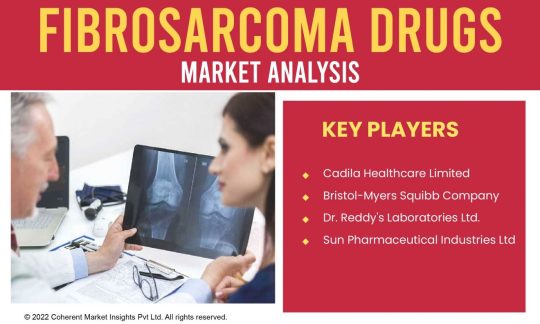
A fibrosarcoma is an inflamed (malignant) tumor that originates from the connective fibrous tissue located at the ends of the bones of the lower arm or leg and then proceeds to spread to other surrounding tissues, causing extreme pain and complications. It's a form of cancer that typically grows slowly over an extended period of time. Fibrosarcoma may develop for several reasons, including: primary tumors at the facial prominences on one or both sides of the heart; fibrosarcoma may develop in response to an infection (such as those that occur in the stomach or esophagus); tumors may also develop on other areas of the body other than the skin. If you have any of these symptoms, you should contact your physician immediately. However, since the symptoms of fibrosarcoma are similar to those of other diseases, and because it's difficult to determine whether a disease exists, most people with fibrosarcoma are sent for check-ups each year.
Market Dynamics
High prevalence of cancer is expected to propel growth of the fibrosarcoma drugs market. For instance, according to the American Cancer Society, in 2019, there will be an estimated 1,762,450 new cancer cases diagnosed and 606,880 cancer deaths in the U.S. Moreover, increasing funding in cancer R&D is also expected to aid in growth of the fibrosarcoma drugs market. For instance, according to the National Cancer Research Institute (NCRI), cancer research funding by NCRI partners reached around US$ 750 million in 2018/19.
R&D in fibrosarcoma is expected to offer lucrative growth opportunities for players in the fibrosarcoma drugs market. For instance, in January 2021, researchers from Children's Hospital of Philadelphia reported that neurotrophic tyrosine receptor kinase (NTRK) fusions are more common in pediatric tumors and also involve a wider range of tumors than adult cancers, information that could help prioritize screening for NTRK fusions in pediatric cancer patients who might benefit from treatment with TRK inhibitors.
Competitive Analysis
Major players operating in fibrosarcoma drugs market include, Cadila Healthcare Limited, Bristol-Myers Squibb Company, Dr. Reddy's Laboratories Ltd., Sun Pharmaceutical Industries Ltd., Baxter International Inc., Eli Lilly and Company, Cullgen Inc., Pfizer limited, Johnson & Johnson., and Celon Laboratories Pvt. Ltd.
Major players operating in fibrosarcoma drugs market are focused on R&D to expand their product portfolio. For instance, in October 2020, Cullgen Inc. announced that the company’s internal program to develop selective degraders that target key proteins within the TRK family has been published by the Journal of Medicinal Chemistry.
0 notes
Text
PD-1 and PD-L1 Inhibitor Market Future Business Opportunities 2023-2028 | Pfizer Inc., Novartis AG, AstraZeneca PLC
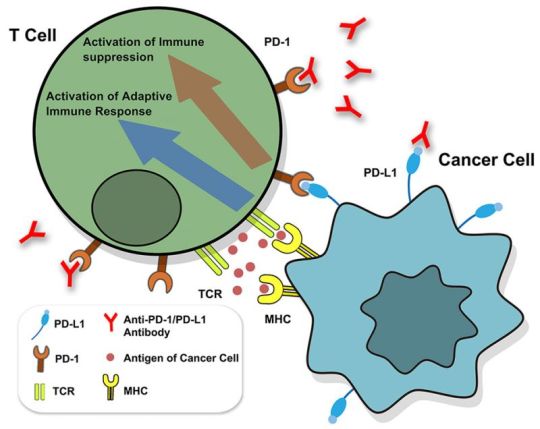
The global PD-1 and PD-L1 inhibitor market was valued at US$ 30,535.5 Mn in 2021 and is forecast to reach a value of US$ 77,541.1 Mn by 2028 at a CAGR of 14.2% between 2022 and 2028. The global PD-1 and PD-L1 inhibitor market is experiencing strong growth due to the rise in incidence or prevalence of cancer and growing geriatric population around the world. Moreover, increase in awareness among people about immune checkpoint inhibitors is expected to boost the growth of the market. However, high cost of cancer treatment and risk of complications associated with the treatment is expected to hamper growth of the global PD-1 and PD-L1 inhibitor market.
Global PD-1 and PD-L1 Inhibitor Market: Regional Insights
Based on geography, the PD-1 and PD-L1 inhibitor market is segmented into North America, Latin America, Europe, Asia Pacific, and Middle East & Africa.
Among regions, North America is expected to gain highest share in the market during the forecast period owing to the increasing prevalence of cancer and favourable initiatives by the regulatory authorities in the region, especially in the United States. For instance, PD-1 and PD-L1 inhibitors are vital immune checkpoint inhibitors used to treat variety of cancer. According to the American Cancer Society, in 2022, there will be an estimated 1.9 million new cancer cases diagnosed and 609,360 cancer deaths in the United States. This in turn is expected to increase demand for PD-1 and PD-L1 inhibitors in the region.
Asia Pacific is also expected to witness significant growth in the global PD-1 and PD-L1 inhibitor market owing to the high prevalence of cancer together with growing geriatric population in this region, especially in India. For instance, according to the cancer report by the Indian Council of Medical Research (ICMR), India’s cancer cases could increase by 12% in the next five years, with 1.5 million people projected to suffer from the non-communicable disease by 2025, up from 1.39 million in 2020. This in turn is expected to increase demand for PD-1 and PD-L1 inhibitors.
Global PD-1 and PD-L1 Inhibitor Market Restraints:
High cost of cancer treatment is expected to hamper growth of the global PD-1 and PD-L1 inhibitor market. For instance, on average, the cost of cancer treatment in India is around INR 503,118 (US$ 6,300) with a minimum expense of INR 90,561 (US$ 1,134) and maximum cost of INR 27,67,149 (USD 34,650). Moreover, the cost of available PD-1 and PD-L1 inhibitors is high, however, the cost of cancer treatment depends on the stage of the cancer.
0 notes
Text
Around 10% of the worldwide population was affected by chronic kidney disease fostering growth of the medical membrane market
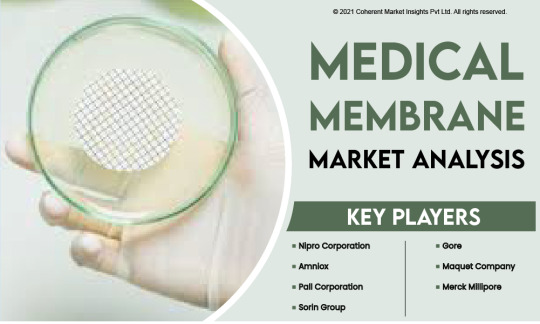
The growing prevalence of infectious chronic diseases such as chronic kidney disease around the globe is augmenting the growth of the medical membrane market. According to the National Kidney Foundation 2018, data around 10% of the worldwide population was affected by chronic kidney disease. Moreover, growing government initiatives in research and development, development in the healthcare industry, pharmaceutical, biotechnology industry, and rising adoption of medical membranes across several industries are major factors propelling the growth of the medical membrane market. On the other hand, high capital investment for the production of membrane and surface fouling is estimated to restrict the growth of the market.
The key players operating in the global medical membrane market include Nipro Corporation, Amniox, Pall Corporation, Sorin Group, Gore, Maquet Company, Merck Millipore, and others
In November 2018, Merck, the vibrant science and technology company launched its new BioContinuum™ Platform to advance biotherapeutic drug manufacturing through improved efficiency, simplified plant operations, and greater quality and consistency
North America is expected to exhibit significant growth over the forecast period and this is attributed to the high prevalence of chronic disease in the region. According to the National Health Council, chronic diseases affect approximately 133 million Americans, representing more than 40% of the total population of this country.2 By 2020, that number is projected to grow to an estimated 157 million, with 81 million having multiple conditions. Moreover, growing initiatives by the government to reduce the mortality associated with kidney disease are also projected to foster the growth of the market. National Institute of Diabetes and Digestive and Kidney Diseases (NIDDK), aims to reduce the mortality and morbidity linked with kidney disease by introducing the initiative National Kidney Disease Education Program.
Medical membranes are manufactured for use in separation processes across the medical industry for use in various applications. They provide high-speed filtration of microorganisms, fungi, and other particles in aqueous solutions to filter out microorganisms, bacteria, and viruses. In addition, medical membranes are widely used in pre-filtration, pretest, analytical method development, dry cell filtering, dilution, analytical method development, dilutive dialysis, sorption, electrodialysis, capillary free flow, submicron filtration, and expression method development. They are also commonly used to cleanse the air, for mechanical ventilation and environmental cleanliness purposes. Medical membranes can be made of vinyl, polyvinyl chloride, polypropylene, ethylene, or other membranes commonly used in many industries.
0 notes
Text
Autologous Stem Cell and Non-Stem Cell Based Therapies Market Analysis

A primary driver for this market is the worldwide increase in occurrence of diabetes and cancer, across all age groups. According to the World Health Organization (WHO) 2018 statistics, the number of people with diabetes has risen from 108 million in 1980 to 422 million in 2014. Moreover according to the World Health Organization cancer factsheet 2018, Cancer is the second leading cause of death globally, and is responsible for an estimated 9.6 million deaths in 2018. Furthermore, increasing old age population is another driver, which is anticipated to create a high growth scenario for the market. As per the World Population Prospects 2019 revision, the number of people aged 80 years or over is projected to be triple, from 143 million in 2019 to 426 million in 2050.
Alternatively, factors restraining the market are complications and risks associated with the treatment including diarrhea, nausea, hair loss, vomiting, severe infections, infertility, and heart complications.
Increasing prevalence of cancer will drive the overall autologous stem cell and non-stem cell based therapies market
According to a report by National Cancer Institute, in 2016, around 1,685,210 new cases of cancer were diagnosed in the U.S. alone. Moreover, it was also noted that around 595,690 people died from the disease in the same year. Autologous stem cell and non-stem cell based therapies is likely to become one of the preferred treatment for cancer. As the prevalence of cancer is rising at a considerable rate, the market is likely to grow during the forecast period.
North America, followed by Europe accounted for the major share of the autologous stem cell and non-stem cell based therapies market. This is due to minimization of risks related with the treatment. Moreover, the demand for these treatments is high due to their ability to cure a significant number of infectious diseases. Autologous stem cell and non-stem cell based therapies do not need an outside donor; therefore the treatment is less infectious and convenient. These factors are likely to boost the growth of the market in North America. However, Asia Pacific is expected to show the maximum growth in the forecast period. The demand in this region will be led by countries such as China, India, Malaysia, and Vietnam. The demand is likely to grow as autologous stem cell and non-stem cell based therapies aid in the efficient management of cardiovascular diseases as well. Growing healthcare infrastructure as well as increasing collaboration and acquisition by market players in this region is also expected to help in the growth of the autologous stem cell and non-stem cell based therapies market in the Asia Pacific. For instance in January 2018, Vericel Corporation made a licensing agreement with Innovative Cellular Therapeutics (ICT) for development and distribution of autologous stem cell based therapy products such as MACI, Epicel, ixmyelocel-T and Carticel in Greater China, South Korea, Singapore, and other countries in the region
Key players in the global autologous stem cell and non-stem cell based therapies market are investing heavily in their research and development activities so as to gain an upper hand in the market. Some of the major players operating in the market are Caladrius Biosciences, Vericel Corporation, Fibrocell Science, Inc., Genzyme Corporation, BrainStorm Cell Therapeutics, Regeneus Ltd., and Dendreon Corporation.
Key players operating in the market has robust pipeline of autologous stem cell and non-stem cell based therapies, which is expected to drive market over the forecast period. For instance in November 2019, Caladrius Biosciences (previously known NeoStem, Inc) announced positive results of CD34+ cell therapy CLBS16 from the ESCaPE-CMD Trial as a significant advancement in treatment of Coronary Microvascular Dysfunction (CMD), a condition that disproportionately afflicts women.
0 notes
Text
Emergence of Covid-19 and High Prevalence of Congenital Heart Disease in Infants to Augment Growth of Fetal and Neonatal Monitoring Market
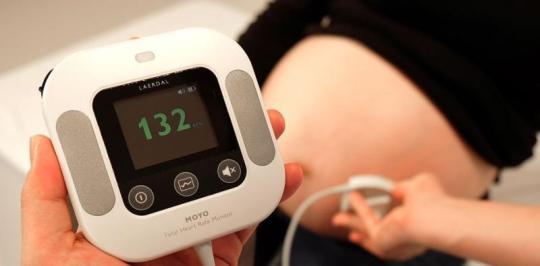
Fetal and neonatal monitoring is a technique of monitoring your newborn's heart and lungs before, during, and after he/she was born. Normally the mother passes all of her body functions to the baby via vaginal deliveries or breastfeeding. A monitor is inserted into the birth canal to detect any irregularities in breathing, heartbeat, or pumping. These monitors are also used in early detection of any problems associated with your unborn baby such as congenital heart disease, breathing difficulties, or infections.
Market Dynamics
High prevalence of congenital heart disease in infants is expected to propel growth of the fetal and neonatal monitoring market. For instance, according to the study, Prevalence, profile, and pattern of congenital heart disease in Central India: A prospective, observational study (published in May 2018), the prevalence of congenital heart disease (CHD) was 10.13/1000 live births. Moreover, emergence of Covid-19 is also expected to aid in growth of the market. For instance, in July 2020, Koninklijke Philips N.V. launched Avalon CL Fetal and Maternal Pod and Patch capable of providing “continuous non-invasive monitoring” of important vital signs such as maternal heart rate, fetal heart rate, and uterine activity.
High rate of maternal mortality in emerging economies is expected to offer lucrative growth opportunities for players in the fetal and neonatal monitoring market. For instance, according to Maternal Mortality: 1990 to 2015 Estimates by WHO, UNICEF, UNFPA, World Bank Group and the United Nations Population Division, Sub-Saharan Africa recorded the highest ratio or maternal mortality, at 555 per 100, 000 live births, from 1990 to 2015. Moreover, the United Nations is focused on achieving the Sustainable Development Goals 2015 - 2030 global maternal mortality ratio target of less than 70 per 100 000 live births.
Among regions, North America is expected to witness significant growth in the fetal and neonatal monitoring market, owing to increasing preterm birth rate in the U.S. For instance, according to March of Dimes 2019 report card, the preterm birth rate in the U.S. reached 10.02% in 2018 from 9.63% in 2015.
Competitive Analysis
Major players operating in the fetal and neonatal monitoring market include, Becton, Dickinson and Company, Fujifilm SonoSite Inc., Medtronic Plc, Dragerwerk AG & Co. KGAA, Cooper Surgical, Getinge AB, MindChild Medical, Inc., Natus Medical Incorporated, GE Healthcare, Siemens Healthcare GmbH, ArjoHuntleigh, Inc., Neoventa Medical, Koninklijke Philips N.V., Analogic Corporation, Spacelabs Healthcare Inc., Smiths Medical, and Masimo.
Major players operating in the fetal and neonatal monitoring market are focused on adopting partnership strategies to enhance their market share. For instance, in April 2019, Henry Schein Medical, the U.S. Medical business of Henry Schein, Inc., and MindChild Medical, Inc. signed an exclusive distribution and supply agreement for the MERIDIAN M110 Fetal Monitoring System.
0 notes
Text
The Global Cerebral Somatic Oximeters Market Continues To Grow Owing To the High Incidence Rate of Neurological Disorders in the World, In both Children and Adults
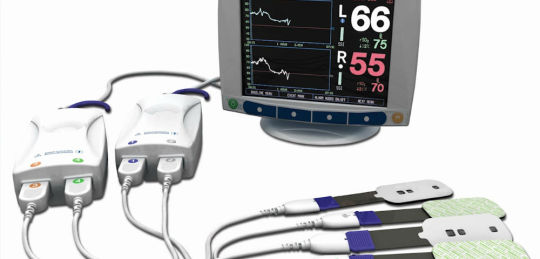
A cerebral somatic oximeter is used in cerebral somatic, which is a specialized test. Cerebral somatic oximeters are used in the field of medical imaging, to track and determine the functioning of the cerebral muscles and organs. It is an electroencephalograph (EEG) device to be used in children who are suspected of suffering from various brain-related disorders such as cerebral palsy, stroke, head injuries, multiple sclerosis, Parkinson's disease, and other disorders.
In this regard, the diagnostic devices gradually moved out of the pediatrician's office and moved into the hospital setting. Pediatric sales agents were instrumental in bringing about the development of this highly useful device, which is widely used in pediatric hospitals today. Cerebral somatic oximeters are commonly used in the hospitals, clinics, and laboratories of cardiologists, orthopedists, neurologists, and psychologists. As a result, the demand for these diagnostic products has tremendously increased as well.
The increase of neurological disorders worldwide has enhanced the growth of the global cerebral somatic oximeters market. For instance, according to CerebralPalsy.org, Cerebral Palsy gets diagnosed in 2.3 to 3.6 children out of 1000. Spastic Cerebral Palsy is the most common in these regards and makes up to around 61% to 76.9% of all the diagnosed cases. Moreover, rapid product approval by international organizations and the constant addition of products in pipelines are also augmenting the growth of the global cerebral somatic oximeters market.
These devices are used to detect the oxygen saturation of blood and the changes related to it. The changes can occur in various regions of the brain and other tissues of the body, which are placed beneath the sensors, in order to detect oxygen saturation effectively. The cerebral somatic oximeter works based on the principle of near-infrared spectroscopy. These devices are widely used in various surgeries related to neurological, and cardiovascular health. However, the high price of the equipment is the main factor, which is negatively affecting the growth of the global cerebral somatic oximeters market.
In North America, the incidence rate of neurological disorders among both adults and children is very high and is increasing constantly, which is propelling the growth of the global cerebral somatic oximeters market. For instance, according to the Centers for Disease Control and Prevention, approximately 764,000 individuals in the United States have at least one of the symptoms indicating cerebral palsy. Over 10,000 babies are born every year with cerebral palsy and around 1200 to 1500 school-going children suffer from the disorder. Moreover, the increasing incidence rate of cardiovascular health issues among adults in the region is also boosting the growth of the market. Owing to such factors, there have been some significant industrial developments in the global cerebral somatic oximeters market. For instance, in August 2020, O3® Regional Oximetry, developed by Masimo got approved by the Food and Drug Administration for somatic applications.
0 notes
Text
Custom Antibody Service Market Segmentation Application, Technology and Market Analysis to 2028
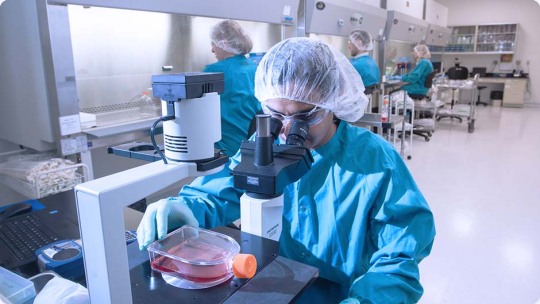
The immune system produces antibodies in response to pathogen invasion. Antigens are the collective term for the invasive bacteria, viruses, or other foreign molecules. Antibodies are proteins, or polypeptides which have specific antigen recognition sites. It is possible to have antibodies made using custom antibody production when an antibody is required against a particular antigen but it is not offered by a supplier. These antibodies can be either polyclonal or monoclonal, depending on how they are produced and harvested. Polyclonal antibodies are capable of recognizing multiple sites on an antigen. They are derived from different B-cell lineages. Monoclonal antibodies recognize only one epitope or site on an antigen, and are derived from a single B-cell line.
Global custom antibody service market is estimated to be valued at US$ 444.85 Million in 2022 and expected to reach US$ 930.46 million by 2030, witnessing a CAGR of 9.7 % over the forecast period (2022-2030).
Advantages of using antibodies for various applications is projected to propel the market growth over the forecast period.
Advantages of antibodies is expected to increase their use for various applications such as research and development, production of therapeutics, etc.
According to the National Center for Biotechnology Information (NCBI): 2020, monoclonal antibodies and polyclonal antibodies are widely used in gold standard techniques such as ELISA, western blotting, flow cytometry, and other affinity based assays or isolation techniques. For ELISA, a monoclonal antibody helps detect a specific antigen of interest. Monoclonal antibodies can also help detect specific cells in flow cytometry. They are also useful for protein purification. Monoclonal antibody can further be used to bind a protein which can then be isolated from its solution.
Global Custom Antibody Service Market – Impact of Coronavirus (COVID-19) Pandemic
Since the COVID-19 outbreak in December 2019, the disease has spread to over 100 countries across the globe. The coronavirus (COVID 19) pandemic and consequent lockdown in various countries across the globe have impacted the financial status of businesses in all sectors. Supply chain and manufacturing activities have been disrupted globally, due to lockdowns implemented by governments of countries, restricted movement, and other COVID-19 safety precautions.
0 notes
Text
Mitochondrial Disorders Treatment Market | Growth, Trends And Forecast (2023–2028)
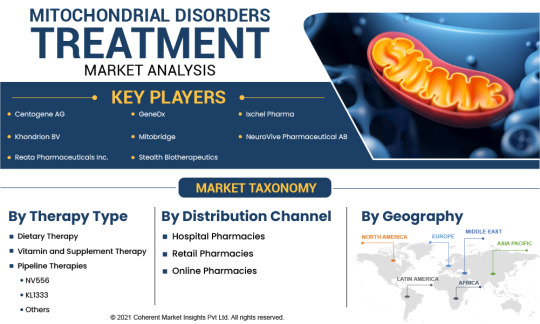
Mitochondrial disorders are inherited chronic disorders characterized by a wide range of biochemical and genetic mitochondrial defects and mutations. The disorder affects multiple organs, which includes brain, heart, liver, skeletal muscles, kidney, and respiratory systems. The patients with mitochondrial disorders often suffer from muscle weakness, exercise intolerance, and fatigue due to reduction in mitochondrial respiration, which is caused due to mitochondrial DNA mutations leading to reduced ability to produce cellular adenosine triphosphate (ATP). Despite major advances in understanding of the molecular mechanisms, currently there are no effective treatments for the disease. The treatment of mitochondrial disorders is mostly performed with different vitamins, co-factors, off-label drugs approved for other indications, and nutritional supplements. However, the research organizations and pharmaceutical companies are involved in development of novel drugs with technology advancements including the use of biomarkers, replacement therapies and sophisticated trial designs, thus creating a lucrative opportunity for the market growth.
Mitochondrial Disorders Treatment Market: Market Dynamics
Increasing prevalence of mitochondrial disorders causing significant morbidity and mortality combined with the higher potential of genetic transmission to the next generation are the factors driving the market growth. According to the Wellcome Center for Mitochondrial Research, 2015, about 10 people per 100,000 have a mitochondrial disorders, which often express first in early childhood. According to the Genetic and Rare Disease Information Center, women with mitochondrial genetic disorders have 50% chance with each pregnancy of passing along the altered gene to the offspring, thus indicating the rising burden of the disease. Also, the mitochondrial disorders treatment market is expected to gain significant traction in the future, as the pharmaceutical drugs approved for the treatment of primary mitochondrial disease have orphan drug status, thereby having a greater potential for market approval than conventional pharmaceuticals. Moreover, the approval of novel drug molecules from the regulatory agencies is expected to create a lucrative opportunity for the growth of mitochondrial disorders treatment market. For instance, in April 2018, NeuroVive Pharmaceutical AB received orphan drug designation to KL1333 by the US Food and Drug administration (FDA) for the treatment of inherited mitochondrial respiratory chain diseases (MRCD).
Mitochondrial Disorders Treatment Market: Regional Dynamics
Regional segmentation of the global mitochondrial disorders treatment market by Coherent Market Insights comprises North America, Latin America, Europe, Asia Pacific, Middle East, and Africa. North America is expected to hold a dominant position in the global mitochondrial disorders treatment market over the forecast period, owing to increasing prevalence of the disease and the rising number of initiatives to spread awareness and support novel drug development. According to the Institute of Medicine, U.S., 2015, an estimated 30,000 Americans are suffering from inherited defects in their mitochondria. Also, according to the Foundation for Mitochondrial Medicine, an estimated 1,000 children per year are born with some form of mitochondrial disease in the U.S. Moreover, the North American Mitochondrial Disease Consortium (NAMDC), a part of Rare Disease Clinical Research Network (RDCRN), specially works towards collecting information from mitochondrial disease patients in a clinical patient registry, thereby helping researchers to identify and recruit patients for future studies.
0 notes